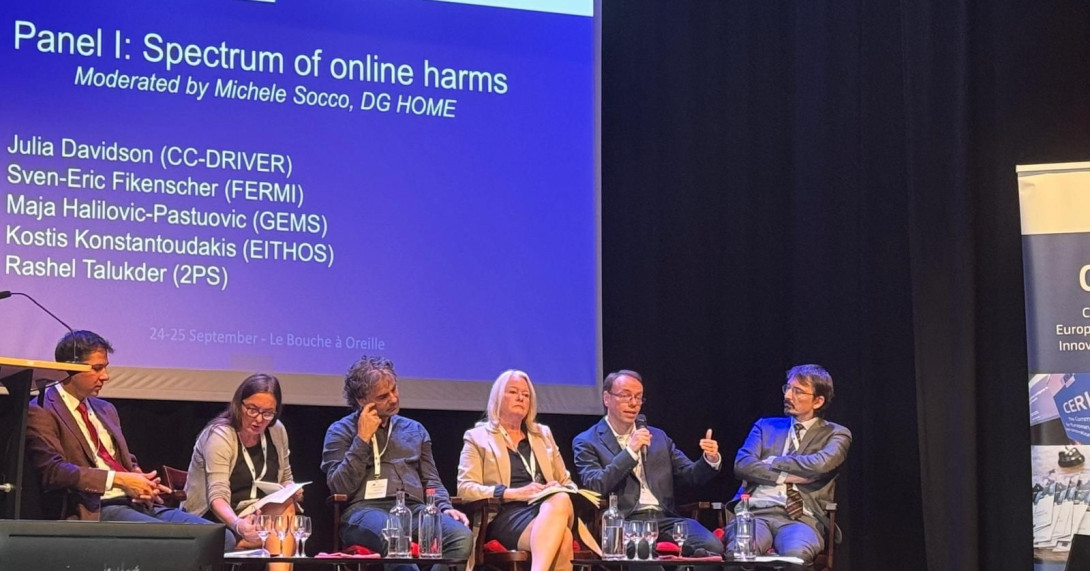
On 24 and 25 September 2024, the Community for European Research and Innovation for Security’s (CERIS) annual gathering on Fighting Crime and Terrorism (FCT) was held in Brussels. The FERMI project coordinator Bavarian Police College (BPA) represented the consortium in the event. As with previous years, the focus of the event was twofold; the first day was dedicated to online harms, while the involvement of practitioners in security research was discussed during day two.
FERMI’S STRONG PRESENCE
The FERMI consortium is proud to announce that its work was featured particularly prominently throughout the two-day meeting, especially on day one that addressed the above-mentioned online harms dimension of security research. In addition to Sven-Eric Fikenscher, who participated in the meeting on behalf of project coordinator BPA, fellow FERMI colleagues Georgios Kolliarakis from the Brandenburg Institute for Society and Security (BIGS) and Johanna Argillander from Poliisiammattikorkeakoulu (PUCF) attended the CERIS gathering.
Sven-Eric Fikenscher presented the FERMI project in a panel discussion on the “Spectrum of online harms”. Other speakers included Julia Davidson (CC-DRIVER), Maja Halilovic-Pastuovic (GEMS), Kostis Konstantoudakis (EITHOS) and Rashel Talukder (2PS), while the session was moderated by Michele Socco from DG HOME. The discussion was centred around the overall outlines of the different projects, the key challenges they are facing, such as exploitation and data access, with a particular focus on crime data, and their key outputs.
Fikenscher highlighted the law-enforcement agencies (LEA)-focused approach of the FERMI project. The FERMI platform does not directly address disinformation detection—a crucial aspect of combating disinformation but not within the mandate of LEAs. Instead, the platform includes a broad range of measures that support investigations, threat assessments, and selecting appropriate countermeasures. The initial pilot phase of the FERMI project, which has just concluded successfully, tested the platform with this focus.[1]
Additionally, the challenges of finding suitable datasets that enable the consortium to estimate the future crime landscape based on disinformation campaigns were discussed. Due to the lack of detailed European datasets on disinformation and crime, the FERMI consortium has relied on US data (at the municipal and county levels), applying it to similar NUTS-2 EU regions with matching demographics and characteristics.
Following the panel discussion, the audience was introduced to FERMI’s key technical models and components through a brief demo, which showcased the platform’s main functions and preliminary results using social media data. FERMI was among four projects (along with EITHOS, RAYUELA, and its sister project VIGILANT) invited by DG HOME to present their technical solutions on stage and in an exhibition room. In this setting, project representatives took turns demonstrating their platforms. These demos provided an excellent opportunity for connecting with CERIS experts, exploring possible joint activities with like-minded projects and uptaking scenarios with interested end-users.
OTHER FORMS OF ONLINE HARM AND STAKEHOLDER INVOLVEMENT
Other than that, the part on the ramifications of online activities included keynotes on “online harms” by Eleonora Forte (Operational & Analysis Centre – Europol), the “AI Act and security research” by Dragos Tudorache (Member of the European Parliament 2019-2024), and “Technologies and techniques to fight cybercrime (state-of-the-art and future)” by Álvaro Azofra (EC3 – Europol). Two further panels on the “Implications of the AI Act for research efforts in fighting online crimes” and “Emerging and future techniques and technologies in online harms vs. related security research efforts in the fast-evolving eco-system” were held. Sexual exploitation, cyber-attacks (especially ransomware), online fraud and online radicalisation were identified as the most profound online harms that require the attention of LEAs and decision-makers, whereas a lack of human talent and resources constitute particularly noteworthy obstacles.
On the second day, speeches on involving practitioners were given by Nicolas Bessot (DG HOME), Valentina Zuri (Europol Innovation Lab) and Jarmo Puustinen (Finnish Ministry of the Interior), who discussed the role of forensic institutes. Panel discussions also reviewed the engagement of police authorities and NGOs/CSOs in these efforts.
[1] More specifically, the pilots are all based on use cases that address the above-mentioned steps in meeting the challenges posed by an illicit disinformation campaign piecemeal. The first use case concerns the investigation of suspicious social media accounts with the help of FERMI’s Spread Analyser, whereas the second aims to carry out a threat assessment using the Sentiment Analysis module and the Disinformation Flows Modeler as well as the Swarm Learning framework, and the third addresses the need to do a cost-based impact assessment with the help of the Behaviour Profiler and Socioeconomic Analyser and examine counter-measures that are proposed by the Community Resilience Management Modeler/Socioeconomic Disinfo Watch.